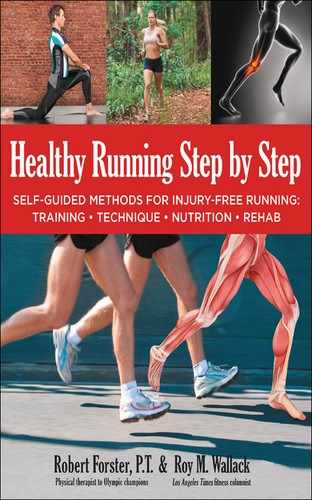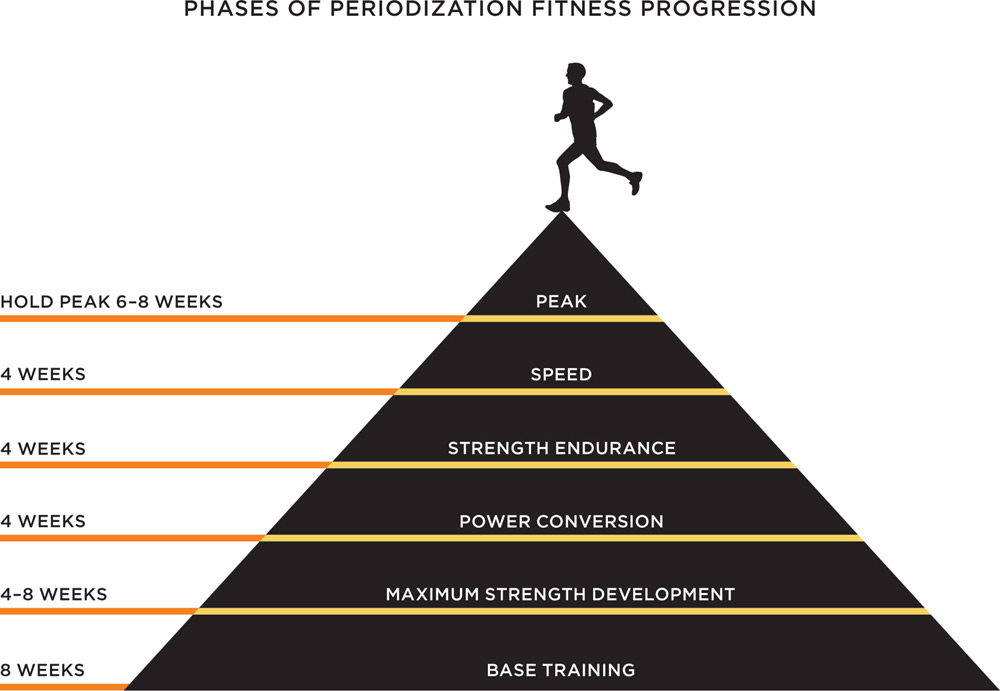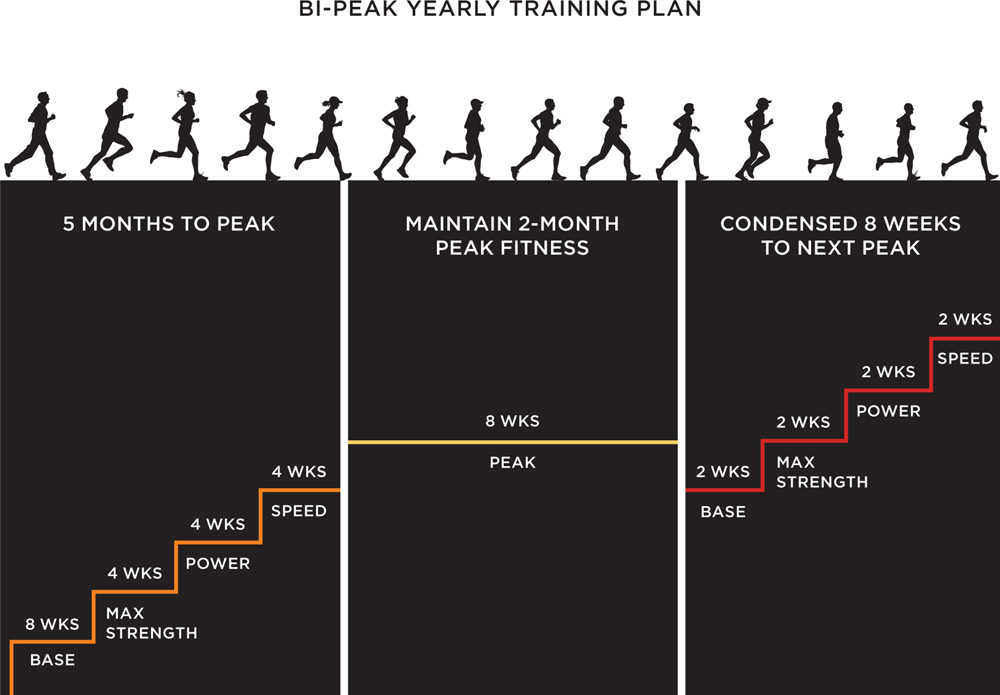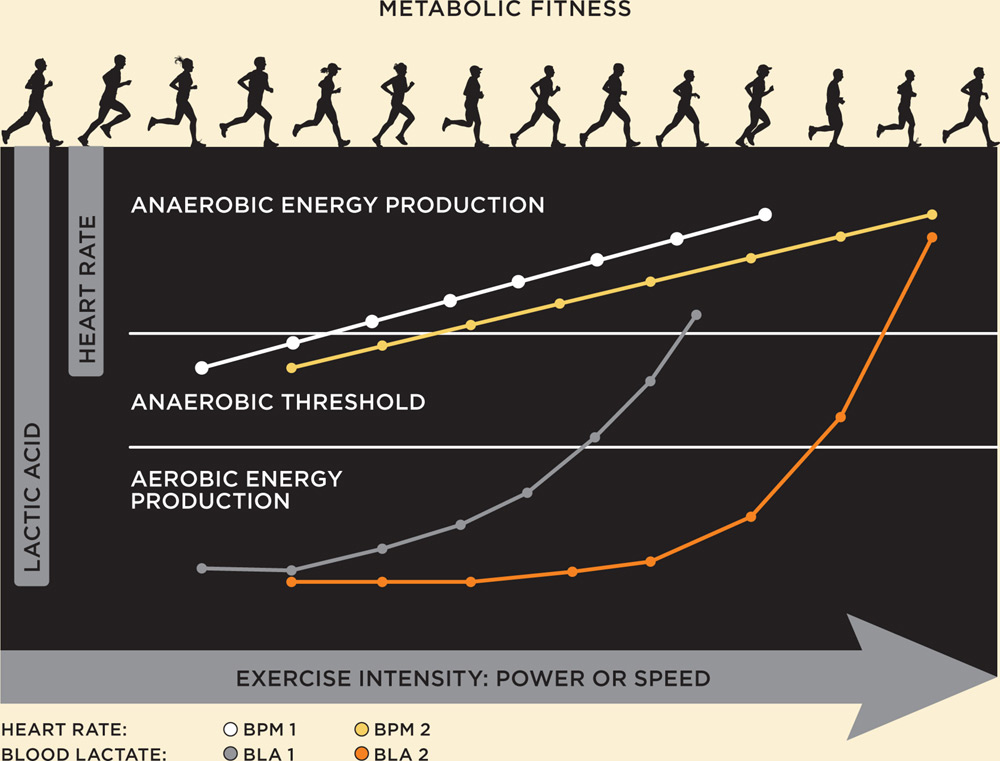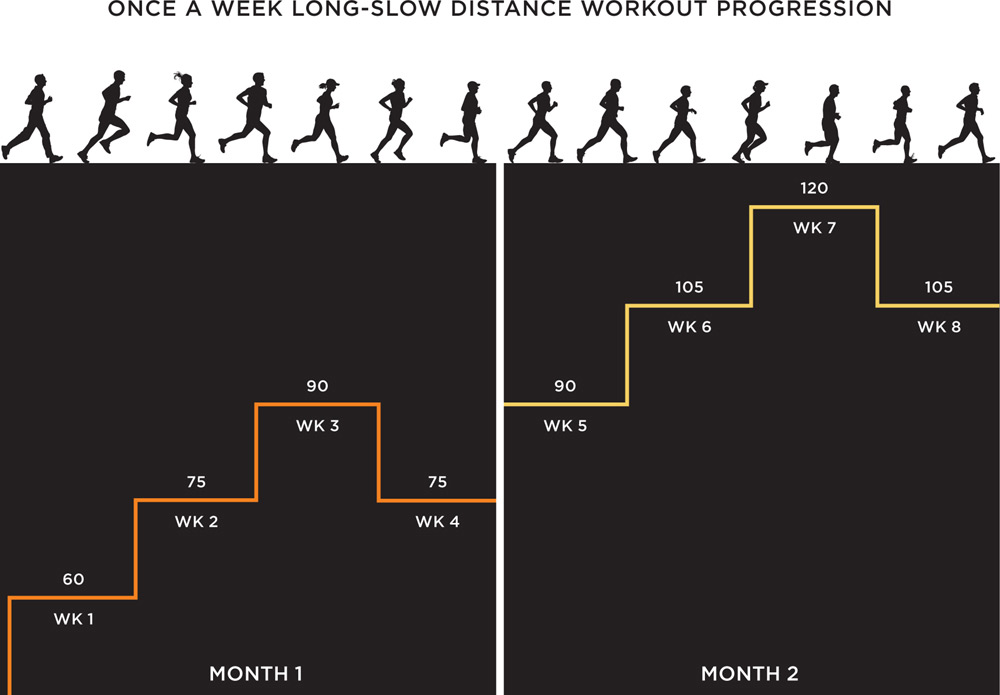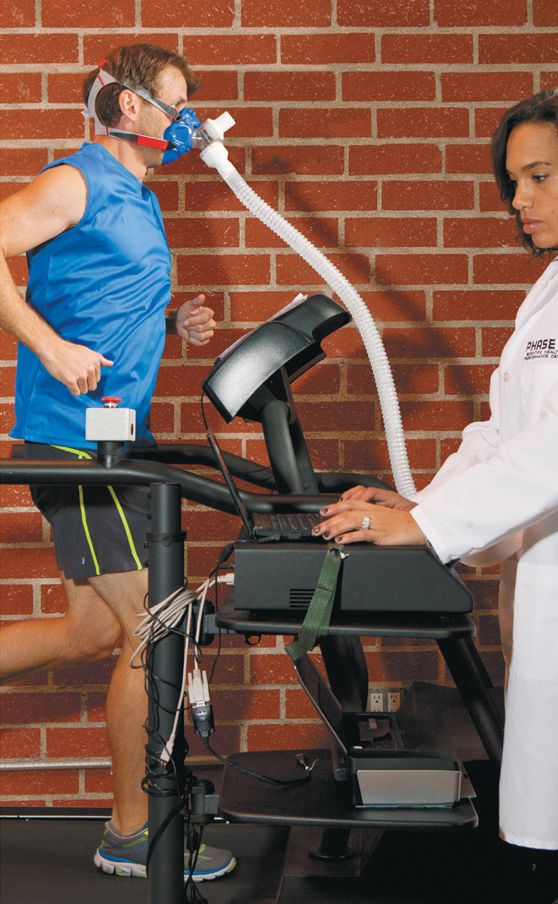4 Periodization Training
To run a race to the best of your ability, and to do it with the least amount of injury, fatigue, and worry, nothing beats Periodization, a near-foolproof stair-step training plan that ramps you up safely and leaves you primed to fly.
If you just want to stay active and don’t care about getting faster or losing large chunks of time to nagging injuries, keep doing your regular run. But if you want to improve, get fitter, stop getting injured, and maybe score a personal record at a race, your run-of-the-mill haphazard training won’t cut it. To kick your running up several notches, you have to train in a way that is good for your body, building it up and speeding it up while limiting the potential for injuries.
To do that, you need a strategy that is almost bipolar, in that it combines increasingly hard efforts with rest days and rest weeks. Over the weeks and months, this hard-easy schedule is the paradigm that gives your body time to heal, recover, and build bigger, stronger, faster muscles and connective tissue.
Sequence is the key. The science shows that you have to properly sequence your training to develop one aspect of fitness at a time and then use that as a foundation to build the next. In fact, to be your fittest by the time the starting gun goes off, you must be incredibly patient. You will spend a long time building a broad base of aerobic infrastructure and musculoskeletal resiliency before adding on layers of higher-intensity work such as hill training and intervals as you approach race day. This strategy is virtually foolproof, used by the world’s best athletes in every sport, and it’ll work for you if you have the discipline to follow it.
It’s called Periodization.
The foundation of all modern training, Periodization was officially christened in 1963 by Tudor Bompa, a former Olympic rower and faculty member of the Romanian Institute of Sport who trained eleven Olympic and World Championship medalists in track and field and rowing. But Soviet sports scientists had already been working on this type of training since the 1950s, conducting controlled research on promising young athletes in isolated training facilities. Able to control diet, sleep, and environment while ignoring inconvenient Western concepts such as consent, they manipulated exercise stimulus in search of the most effective training program design. The results may have been ethically corrupt, but they proved to be scientifically sound.
The volume of work is greatest in base training and must decrease with the higher intensity in successive Perodization training phases.
What emerged was a model of human adaptation that provides predictable outcomes when exercise is orchestrated in a scientifically rational sequence. Of course, after what became known as Periodization was used with great success by Iron Curtain athletes, the West started getting on board with it in the 1970s.
Basically, the Periodization model builds the athlete up to optimal performance with a stair-step series of methodical, progressive challenges and recoveries that strengthen your body and keep brain and brawn fresh. It starts with a goal (such as a marathon or 10k) and plans a workout schedule leading up to it, breaking up your training time for your targeted event into five training cycles or phases, each with a specific fitness goal in mind.
Periodization plays out like this:
Periodization schedule showing how to achieve two fitness peaks (one at the end of 5 months, the second at the end of 8 weeks). Use this schedule when training for two races in one year, for example.
Phase 1: Base Training
This is an 8-week training cycle of gradually ramping up the miles, with the dual goal of building up your metabolic (oxygen-processing capacity) and structural foundation (bone, muscle, and joint strength) as well as your fueling system. The latter refers to using low-intensity “aerobic” training to teach your body to rely mainly on fat, which all bodies have a huge supply of, for fuel. The gradual ramp-up also hardens the structural components of your body against injury for the tougher workouts to come. At the same time, you also will be using light weights to build a strength base; that will isolate and strengthen all the little “helper” muscles that act to stabilize each joint and perfect your running mechanics.
Phase 2: Strength Development
This is a 4- to 8-week training cycle of gradually increasing intensity that uses hill running and weight lifting with heavy weights to increase the strength of the tendons, bones, and the bigger muscles that propel you forward.
Phase 3: Power Conversion
This is a 4-week training cycle designed to convert the strength developed in Phase 2 into running power—so that muscles can contract faster and harder. To do this, you need more anaerobic power, which is achieved with hill repeats and intervals and explosive movements in the gym with lighter-weight loads.
Phase 4: Speed or Strength Endurance
This is a 4-week cycle that brings your fitness to a peak of speed or strength endurance, depending on whether you are preparing for a 5k or 10k or the longer races. It uses shorter, harder intervals to hone your anaerobic fitness and super-lightweight loads in the gym for high-rep sets that make your muscles more fatigue resistant.
Phase 5: Taper and Peak
In this short period, usually the last 2 to 3 weeks before your event, you shorten your workouts but keep up the intensity, leaving you razor sharp and well rested to do your best on game day.
Phase 6: Transition
When it’s over, you chill out a bit with easy running and cross-training designed for recovery. Then get ready to start all over again on the next goal by starting with base training again.
In a nutshell, Periodization proves that the development of substantial physiological infrastructure must precede the hard work of the later phases as you approach competition. Without developing the necessary infrastructure first through base training, and progressively in the strength development phase, the hard work needed to prepare for competition will not be as effective and also may not be tolerated, leading to injury, overtraining, or illness. Periodization’s five training phases ultimately help you avoid the danger zone for all runners: overtraining, which leaves you burned out, sick, injured, and with suboptimal performances.
The Basic Laws of Periodization
Periodization Law #1: Recovery Is Essential
The most important thing to remember is that all work is futile if you don’t allow recovery. No one ever became stronger during a workout; it’s only afterward, during the recovery time, when your fitness evolves. Recovery is built into all Periodization training models because it’s needed, whether you feel like you need it or not. Each week has hard and easy days of training, and every 4 weeks a lighter week is provided for recovery. At the end of the training year, you get to kick back a bit for a number of weeks.
Periodization Law #2: Go Slow-and-Long, and Hard-and-Short
In Periodization, the volume of training (weekly mileage) is always inversely related to the intensity of those workouts. After all, the harder you work, the less work you can do. So as your training progresses toward your competition phase and your intensity rises, your weekly volume of training miles must come down.
Periodization Law #3: Remember the 8-Week Rule
Central to Periodization science is that you shouldn’t perform any type of workout for more than 8 weeks at a time. The human body reacts to the stress of training with an increase in natural anabolic hormones. These include testosterone (even in women), growth hormone, and insulin. These hormones help you adapt to the stress—in other words, become stronger.
But after about 8 weeks, fully adapted to this one type of stress, the hormone response to it fades because the body no longer sees that particular type of training as stressful. Continuing to perform the same type of training without the benefit of this hormonal backup will then create a state of overtraining. That’s why, after 8 weeks, the training stimulus must be altered to create a different type of stress and trigger another hormonal upsurge. In this way, Periodization training has been called natural doping because it keeps your hormonal system peaked throughout the year. People get confused. They do low-intensity base training and think, “How can I get overtrained?” Well, after 8 weeks, even low-intensity exercise makes the body stale.
Periodization Law #4: Push Your Fitness Up Slowly
Instead of going out and doing a superhard workout in an attempt to get up to speed quickly, you have to take it slow with workouts that are in line with your current level of fitness and progress from there. Otherwise, you risk suffering plateaus, burnout, and injury. Workouts do not define your fitness; your current fitness dictates the appropriate level and intensity of your next workout.
Periodization Law #5: Don’t Screw Up Phase 1—It’s the Key
You can get very, very fit on Phase 1 alone, although it won’t leave you at your tip-top peak. In fact, the biggest fitness gains are accomplished in this first and most critical phase. This is where the foundation of all fitness is created. But rushing Phase 1 and trying to attain a fitness peak too early creates an artificial ceiling on how fit you can get and may even set you back with burnout and injury.
Periodization Law #6: Train Slower to Go Faster by Burning More Fat
Although counterintuitive, starting your training with low-intensity aerobic exercise is the best way to run faster later. That’s because it turns you into what I like to call a better butter burner—someone with a monster aerobic system loaded with muscle cells that have an enhanced ability to produce energy from fat. Aerobic means that you are going slow enough to give your body all the oxygen it needs, and an oxygen-rich environment uses a relatively slow-burning fuel such as fat more easily. When you increase your speed to where you can’t meet your oxygen needs, your body reaches for a faster-burning fuel—carbohydrates. By training your body to burn fat, you solve three problems:
• You won’t bonk, because your cells reach for less of the limited carbohydrate stored in your liver and muscle cells, leaving enough to last until the end of your race.
• You can eat less during your race—i.e., require fewer calories—because you can tap the unlimited supply of fat stored on your body. That will reduce the risk of gastrointestinal distress (cramping, bloating, gas, or worse).
• You produce less lactic acid, meaning you become less fatigued. Lactic acid is a by product of carbohydrate combustion. An added benefit of your monster aerobic system is that when you produce lactic acid during a hard anaerobic effort, such as climbing a hill or speeding up to catch a competitor, that lactic acid will be used by your aerobically fit muscle cells as an energy source. So you feel stronger through the race.
Periodization Law # 7: You Must Simultaneously Build Metabolic Efficiency and Structural Fitness Integrity
In each phase of Periodization training, you address each of the Four Pillars of Health and Performance discussed in chapter 1, with close attention to building your metabolic and structural systems together. This ensures that your engine (your muscles, including the heart, and lungs) doesn’t blow out your frame (bones and joints), which can greatly set back your training. For more details, see “Metabolic Efficiency and Structural Integrity: Why They Must Grow Together” on pages 58–59.
The Five Phases of Periodization in Detail
To recap, Periodization uses five periods, or phases, to prepare you for your goal. Each phase has a specific metabolic and structural conditioning purpose and can last anywhere from 4 to 8 weeks (but never more), depending on your objective and time frame, whether it be a 5k, 10k, or a marathon. In Periodization, every workout in a months-long agenda is performed with a specific objective in mind. I always tell my athletes, if you don’t know the purpose of today’s workout, take off your running shoes and go figure it out before you start your run.
Below, find each phase described in detail. Note: The training durations will be based on a 5-month training schedule for a marathon.
PHASE 1: BASE TRAINING
Duration: 2 months
Running plan: Long, slow, flat
Weight training: 2 to 3 days per week using light-weight exercises to isolate the small helper muscles around each joint that provide stabilization
Intensity: 55 to 75 percent of maximum heart rate (HR). (To measure your maximum HR, see the field test section in “Finding the Line between Aerobic and Anaerobic” on pages 68–69.)
Volume: Increasing
Daily nutrition: Speed up development of a fat-burning metabolism by matching your diet to the goals of this phase. By eliminating all processed sugars, including soda, candy, and baked goods, you can help your body learn to use its cleanest-burning fuel: fat. Consume healthy fats and lean protein to provide energy for the workouts and to rebuild your body afterward.
Metabolic focus: This 2-month base-training phase is broken up into two 4-week subphases—base 1 and base 2—in which training volume (duration and frequency) slowly increases in stair-step fashion. When you begin a new subphase, you’re able to perform more work than the previous one. To visualize it, imagine the profile of two flights of stairs (see illustration on the next page). The first flight has three steps up and one step down to build in some recovery. The first step of the second flight starts at the same elevation as the third step of the first flight, in essence repeating the same effort but in a recovered state. The second and third steps of the second month are truly a buildup of your workload, as you are several steps higher than week 3 of base 1.
Key to success: Go slow. Gradually ramp up the miles with no more than a 10 percent increase per week. Be patient. Hold back. Fight the urge to pick up the pace, to increase intensity. Mark Allen, maybe the best runner in the history of triathlon, successfully demonstrated the benefit of this in the early ’90s with Low Heart-Rate Training, a then-unique training method in which he deliberately kept his heart rate low, slowly building his base on his way to the last of his six Hawaii Ironman championships. Base training is all about low-intensity workouts at maximum volume—long-slow distance (LSD) runs.
The numbers on top of each step represent the time in minutes of each long-slow distance (LSD) run performed once a week.
Don’t forget that the purpose of these gradual, stepwise increases in training time or mileage is to prepare your body and gain confidence for the harder work to follow. Physiologically, you are building up the components of your aerobic foundation: stronger muscles, thicker tendons and bones, and multitudes of mitochondria with miles of capillaries, which are slower to respond to stimuli than your heart and lungs—all the more reason to throttle up slowly.
Face the scientific fact that you cannot do any high-intensity training while trying to develop your metabolic efficiency (base) in this phase. Intense exercise now will outrun your ability to process enough oxygen to burn fat, and you will go anaerobic (without oxygen): Your body, trying to keep going, then reaches for a quicker-burning fuel—your precious, limited stores of carbohydrates. Going harder will remove the stimulus for your body to develop more mitochondria and capillaries to build your aerobic engine. Later, you’ll need to rely on them to stay longer in fat-burning mode at higher intensities of exercise.
Rest is also the key. Each 4-week subphase ends with a rest-and-recovery period, whether you think you need it or not. Science shows that you do. Three weeks harder, then one week easier. The fourth week is the all-important recovery week that calls for a significantly reduced workload (60 percent of the previous week’s total mileage) that refreshes your mind and body, letting all your systems adapt to the stresses of training and come back even stronger. Warning: Don’t train hard through your recovery week. You’ll exhaust your body, stall your progress, and risk injury.
But recovery, as we’ve mentioned before, is not limited to this one week. A recovery workout should follow any hard or long workout, no matter the week or the phase.
Recovery doesn’t necessarily mean sitting on the couch, although doing so one day of each week won’t hurt. On recovery days, go out for shorter, lower-intensity runs, or cross-train: swim, do the elliptical machine, or ride the bike. Stay aerobically active, but lower the burners. A recovery workout doesn’t produce additional stress; its low intensity is rejuvenating—like a massage. Recovery permits the body (and mind) to test the limits of athletic potential without falling over the edge into overtraining/underrecovery.
By the end of the 2-month base-training period, a prospective runner should have built his or her body up to the point where it can survive a 10- to 12-mile (16- to 19.2-km) run. For 10k runners, this would be 10 miles (16 km), for half-marathoners build up to 15 miles (24 km), and for marathoners, build up to 15 miles (24 km) on your way to your eventual maximum of 18 to 24 miles (28.8 to 38.4 km) in the next 2 months.
Whether you compete in 5ks, marathons, or Ironman triathlons, you are best served by developing a monster aerobic system. Building it requires extended periods of low-intensity exercise to force the above adaptations—and can be seriously sidetracked with even an occasional bout of higher-intensity work.
For finding your optimal fat-burning zone, see “Finding the Line between Aerobic and Anaerobic” on pages 68–69.
Nutritional optimization: In pursuit of metabolic efficiency, skip the sweet, sugary gels and hydration drinks during training and instead consume real food that contains healthy fats and protein (e.g., nut butters, nuts, jerky) and an electrolyte drink with little to no carbs. Limit processed carbohydrates such as whole-wheat bread in your daily diet as well and replace them with vegetables, beans, and legumes. This will speed your conversion into a better butter burner.
During base training, skip the gels and opt for healthy food. Nuts, for example, are an excellent snack food or training fuel.

In the base training phase, avoid complex carbohydrates such as bread and grains, and instead include more legumes and vegetables in your diet.
Structural focus: Weight training in these initial months is designed to isolate the smaller helper muscles that stabilize the pelvis, core, and shoulder girdle—that is, the skeletal anchors for the big prime movers that will eventually propel you forward. You’ll train these smaller muscles with light weights (2 to 8 pounds [910 g to 3.6 kg]) in very specific movements to make them work better in their stabilizing roles (see the Runner’s Dozen on page 150). This will create efficiency in your running gait by enabling you to maintain a rock-solid core when the larger muscles contract and pull and tug at your skeleton.
Light weights and higher repetitions stick to the overall low-intensity but higher-volume nature of this phase of base training. Accordingly, this is the time period when weight workouts are a bit longer but easy to perform. Weight training is best saved for your 2 or 3 shorter-run days of the week.
Stretching and rolling should become second nature and a part of every workout. They will help you adapt to the workouts and further enhance your ability to attain the efficient running mechanics you need to perform at your highest genetic potential.
Bottom line: Train right and develop your base with all the positive adaptations—structural and metabolic—derived from a scientific training methodology that will benefit you in all future athletic endeavors. In combination with technique drills, a sound flexibility program, and weight training (see chapters 2, 7, and 8, respectively), Periodization-based training guarantees you’ll have a great foundation to build the highest levels of injury-free peak performance.
When you have finished these 2 months of base training, it’s time to move on to a strength phase with low-heart-rate hill running and lifting heavier loads in the gym.
PHASE 2: STRENGTH DEVELOPMENT
Duration: 1 month
Running plan: Increasing intensity up to but not exceeding anaerobic threshold (AT). The AT is above lactate threshold (LT), where another shift in the energy production continuum occurs. Between LT and AT, your body is using an increasing percentage of carbs in its fat-carb fuel mix to meet energy demands. One day each week, do a low-heart-rate hill-climbing session to build strength.
Weight training: Target big prime-mover muscles using multijoint exercises with loads in the range of 75 to 85 percent of your one-rep max (see chapter 8).
Intensity: 75 to 80 percent of the maximum heart rate you achieve in a field test performed after you finish base training. (See pages 68–69 to find this heart rate zone.) You will use longer intervals up to anaerobic threshold.
Volume: Increasingly longer LSD runs
Daily nutrition: Stick to low-glycemic foods for your daily diet but add a hydration drink with a carb-protein mixture for longer runs.
Metabolic focus: After building your metabolic and structural foundation in Phase 1, your objective with Phase 2 is to raise your body’s ability to tolerate the kind of hard work your goal requires—to, say, climb several miles without significantly slowing down. Your tools include low-heart-rate hill climbing, sustained long intervals (“cruise” intervals), and moderately higher-intensity training sessions than in the previous phase.
Technically, in Phase 2 you are trying to raise your AT, the point at which you begin to burn more carbohydrate than fat and produce lactic acid, a metabolic waste product. This is achieved with 15- to 20-minute cruise intervals up to your AT heart rate twice a week. The way to determine your AT is with the field test (see “Finding the Line between Aerobic and Anaerobic” on pages 68–69). The talk test will not help you determine AT.
Because what isn’t trained gets detrained, long efforts are still part of the strength phase. Do a long-slow distance (LSD) run every second week in Phase 2. The mileage for this run should be close to your longest day of base training unless you are training for the marathon, in which case you will extend your biweekly LSD run to 18 to 20 miles (28.8 to 32 km), in 2-mile (3.2-km) increments. To prevent overtraining, in all cases follow the run with recovery time.
During this period, all runners will perform their peak weekly mileage because their intensity is about to climb, and so overall volume must start to decline per the basic tenet of Periodization: Weekly volume is inversely related to intensity.
Nutritional optimization: When attempting to increase lean body mass (i.e., muscle), eat adequate amounts of healthy protein with every meal. Your running and weight training will require that you eat approximately .9 grams of protein per day per pound of body weight. Continue to stay away from simple sugars and processed carbohydrates. Instead, eat lots of vegetables, beans, and legumes.
Structural focus: Strength-training workouts in this phase are shorter, with fewer overall sets and reps (i.e., volume). You will target the bigger muscles using heavier weights that still allow you to complete 10–12 reps using good form. Again, as intensity is increased, overall volume of your gym work must come down. As opposed to isolating the smaller helper muscles that function to stabilize the pelvis, core, and shoulder girdle, you will now target the prime movers themselves with compound movements. Your stretching and foam roller habits should be well developed by now and will play a big role in recovery and helping you avoid injury from these more taxing workouts.
PHASE 3: POWER CONVERSION
Duration: 4 weeks
Running plan: Cut mileage and add shorter intervals (6–8 minutes) that extend into the submaximal heart rate zones (above 85 percent of max heart rate, as determined by a new field test). If your goal race is hilly, add hill repeats.
Weight training: Shorter workouts using lighter weight loads (50 to 60 percent of your one-rep max) for quick movements to develop power.
Intensity: Intervals up to 75 to 85 percent of maximum heart ratefor 6–8 minutes with a recovery interval of 3–4 minutes in between
Volume: Reduced
Daily nutrition: Now you are a better butter burner who is able to burn fats at higher intensities, you will need to add more carbohydrates for the harder, more anaerobic workouts in this phase.
Metabolic focus: Training in this phase is all about putting your hard work to good use by converting your newfound strength into power, an essential ingredient of speed. Strength is defined as the ability of your muscles to contract and create a force. Power puts a time element into the equation; it’s the ability to develop force quickly. Power training will now force your muscles to contract faster and apply the force to the ground in a shorter period of time. This faster ground-reaction time multiplies the forces that will propel you forward. Power is developed with shorter, higher-intensity intervals and short hill repeats. Intervals develop your anaerobic energy production systems by pushing the pace past the point where your aerobic system can take in enough oxygen to sustain the effort. Hence the word AN-aerobic—“without oxygen.”
As your body begins to burn carbohydrates anaerobically, it produces lactic acid. Your body, primed by the on-again/off-again nature of the intervals, learns how to clear the lactic acid or use it as fuel for your struggling aerobic energy system.
Intervals will tax your metabolic and structural systems to the highest degree; therefore, it’s essential to focus on recovery, which will help lessen the chances of getting sick or injured. Recovery starts with 8 hours of sleep per night. It also includes seriously practicing the recovery techniques you’ve already learned and honed. So you should stretch and roll religiously before and after every workout. And don’t rush your warm-up or cooldown; they will limit the amount of cellular damage suffered in each workout and allow you to recover better afterward.
Nutritional optimization: Now that you have achieved metabolic efficiency and turned yourself into the proverbial better butter burner, you can safely add more healthy carbs (vegetables, beans, legumes, etc.) to feed the anaerobic energy system as you bump up the intensity.
Structural focus: Your weight training in this phase is all about getting the muscles to contract faster and move the weights quicker as you turn strength into power. You will use the same multijoint exercises as in the strength development phase but reduce the load to 60 percent of your new one-rep max for each exercise (see chapter 8) and increase the speed of your movements. This newly created power will help you pop over hills and provide the raw ingredient needed for speed. You can also develop power through the use of plyometric exercises.
PHASE 4: SPEED OR STRENGTH ENDURANCE
Note: Here’s where the training program for 5k and 10K runners diverges from that for half- and full marathoners.
Duration: 4 weeks
Running plan:
• 5k and 10k: Volume (weekly mileage) decreases further as intensity is increased to develop speed.
• Half- and full marathon: Mileage decreases except for your long-slow distance run, which builds to 15 miles (24 km) for half-marathoners and 18 to 23 miles (28.8 to 36.8 km) before you begin to taper.
Intensity: High for 5k and 10k runners and moderate for half- and full-marathoners
Volume: Reduced
Weight training: Taper the weights to once per week using the same multijoint exercises as the power and strength phases but do higher reps (30) with extremely light loads.
Daily nutrition: Feed the body more carbs for hard days and lighten up for rest and recovery days to avoid weight gain as you reduce overall mileage.
Metabolic focus: Now you are ready to put the final ingredients in your fitness recipe for peak performance.
• 5k and 10k: Overall mileage comes down 1–3 minutes again, as does the length of your intervals, but intensity is at an all-season high with short intervals on the track.
• Half- and full marathon: For these distances speed translates into efficiency and fatigue-resistant muscles able to hold good form. This is accomplished with mile repeats on the track with the focus on holding form more than absolute leg speed. This phase is all about reinforcing good running mechanics in a fatigued state.
Nutritional optimization: Now that you have achieved metabolic efficiency and turned yourself into the proverbial “better butter burner,” you can safely add more healthy carbs (e.g., vegetables, beans) to feed the anaerobic energy system as you bump up the intensity.
Structural focus: At this point in your training, approaching peak fitness with your running intensity at the highest point of your training cycle, you have to bring the weight-training intensity way down. The weight-room focus of this phase of training is designed to build fatigue resistance into your muscles. With high reps and low weights your muscle endurance will increase, but your muscles will not be tight and sore for your harder running workouts. Perform two sets of thirty reps with just 20 percent of your one-rep max weight. Build the reps by ten per set up to two sets of fifty reps by the third week of this phase.
PHASE 5: TAPER AND PEAK
Duration: 2 to 3 weeks, depending on your event’s length and difficulty
Running plan: Reduced mileage, with hard workouts every 72 hours
Intensity: High
Volume: Reduced
Weight training: Light weight training continues once per week for the first and second week, with no weights during the week of the race.
Daily nutrition: Taper your calories, too, and limit them to all high-octane foods, including high-protein foods and nutritious soups with lots of vegetables.
The taper will make or break your entire training season. This is where all your hard work is actualized, but only if you understand the true purpose of tapering workouts. Tapering is not just allowing for total recovery; in fact, the week before your taper is a recovery week. Tapering is about using your newly acquired fitness to push your performance levels higher, but staying fresh. To reach the peak, you get all the systems firing together. This phase is like putting new wheels on your rebuilt race car and seeing how fast it goes and how well it corners for a few laps.
To make sure you peak, alternate hard, short efforts with lots of recovery, and keep the volume low. You work out just enough to sharpen up but gain a deep recovery that will leave you fresh. Beware of working out too much—you’ll be fatigued on race day. It’s a fine line that plenty of athletes have botched because they feel great, their legs have plenty of bounce in them, and they can’t resist letting the horses run too much. You can walk the line successfully if you follow three rules:
• Rule #1: Avoid the urge to go for one last long run. You cannot develop any more fitness, but you can tire yourself out and sabotage the event for which you’ve been training for months. The stress levied on your body must now be unloaded for your top-level fitness to show up with you at the start line.
• Rule #2: The taper should be 3 weeks for half- and full marathons. For your most important “A-list” 5k or 10k, taper your workouts for 2 weeks.
• Rule #3: Maintain intensity, but cut training volume by 25 percent the first week, and then reduce it another 25 percent the second and third weeks. Shave duration from longer efforts. Reduce training frequency to every 72 hours as opposed to every 48 hours for the preceding training phases. You can hold a peak for a month, but not much longer, so when targeting several events, keep them close together on the calendar.
PHASE 6: TRANSITION
Duration: 2 to 6 weeks, depending on how taxing your last race or series of races was
Running plan: Unstructured routine of easy running and cross-training
Intensity: 55 to 75 percent of maximum heart rate
Volume: Low
Daily nutrition: Splurge a bit but make it with whole foods made with healthy ingredients.
After your event is over, spend the next 2 to 6 weeks in an unstructured active recovery period, giving the mind and body a break from regimented training. The length of the transition period depends on the length and difficulty of your training program. Swim or bike for fun, play tennis, or try a new sport. Give your legs a break but stay active so you don’t lose all your fitness and gain weight.
The days of getting in great shape only to see it disappear because of burnout, long lay-offs, and injury are over. Year-round aerobic fitness and joint stability is the new normal, because Periodization lets you keep your mind and body fresh!
